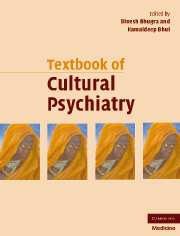Book contents
- Frontmatter
- Contents
- Contributors
- Foreword
- Preface
- Part I Theoretical background
- Part II Culture and mental health
- Part III Culture and mental disorders
- 15 Neurosis
- 16 Schizophrenia and related psychoses
- 17 Affective disorders
- 18 Substance misuse
- 19 Culture and mental disorders: suicidal behaviour
- 20 Personality disorders and culture
- 21 Culture and obsessive-compulsive disorder
- 22 Culture and eating disorders
- 23 Childhood and adolescent psychiatric disorders
- 24 Culture and schizophrenia
- 25 Disorders of ageing across cultures
- Part IV Theoretical aspects of management
- Part V Management with special groups
- Part VI Cultural research and training
- Cultural psychiatry: the past and the future
- Index
- References
15 - Neurosis
from Part III - Culture and mental disorders
Published online by Cambridge University Press: 11 August 2009
- Frontmatter
- Contents
- Contributors
- Foreword
- Preface
- Part I Theoretical background
- Part II Culture and mental health
- Part III Culture and mental disorders
- 15 Neurosis
- 16 Schizophrenia and related psychoses
- 17 Affective disorders
- 18 Substance misuse
- 19 Culture and mental disorders: suicidal behaviour
- 20 Personality disorders and culture
- 21 Culture and obsessive-compulsive disorder
- 22 Culture and eating disorders
- 23 Childhood and adolescent psychiatric disorders
- 24 Culture and schizophrenia
- 25 Disorders of ageing across cultures
- Part IV Theoretical aspects of management
- Part V Management with special groups
- Part VI Cultural research and training
- Cultural psychiatry: the past and the future
- Index
- References
Summary
EDITORS' INTRODUCTION
Although there have been concerns about the use of the term neurosis, which has been eliminated in DSM IV, the term has been retained in ICD-10 and used widely, although pejoratively at times. The prevalence of neurosis varies across cultures and the cultural pressures determine how these symptoms persist. The classical example of this is the use and diagnosis of the term neurasthenia. Used extensively in the Far East, China and other nations, the symptoms are not too dissimilar to depression or chronic fatigue and the diagnosis carries a social cachet.
In this chapter, Chaturvedi and Desai provide an overview of the concept of neurosis. They point out that neurosis is considered a maladaptive pattern of behaviour following a stressful situation which leads to an avoidance of responsibility and the stressful situation itself. They argue that there must be an evidence of stress, the reaction to the stress must be maladaptive and there should be an evidence of anxiety proneness. The anxiety provoking situations in the past should have resulted in excessive nervousness, depression or somatic symptoms. They point out that not only is the diagnosis influenced by culture but the importance given to symptoms and the meaning assigned by the clinician will depend upon culture. These symptoms may reflect a failure to cope but may also be a cry for help, requiring support and understanding from the friends, families and professionals.
Introduction
The term ‘neurosis’ has been ascribed various meanings and definitions.
- Type
- Chapter
- Information
- Textbook of Cultural Psychiatry , pp. 193 - 206Publisher: Cambridge University PressPrint publication year: 2007
References
- 3
- Cited by



